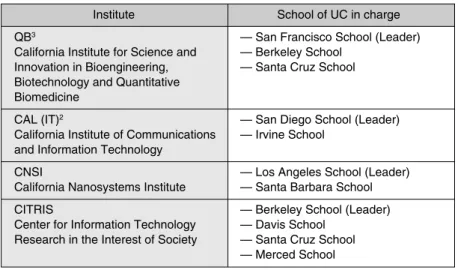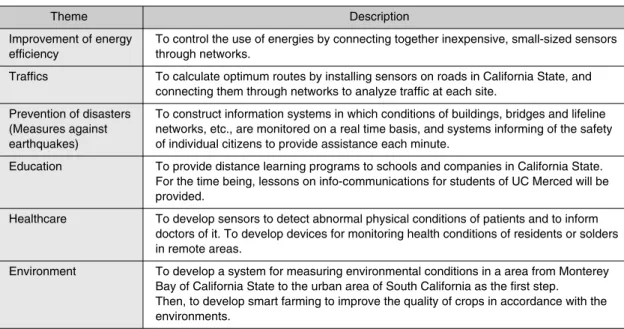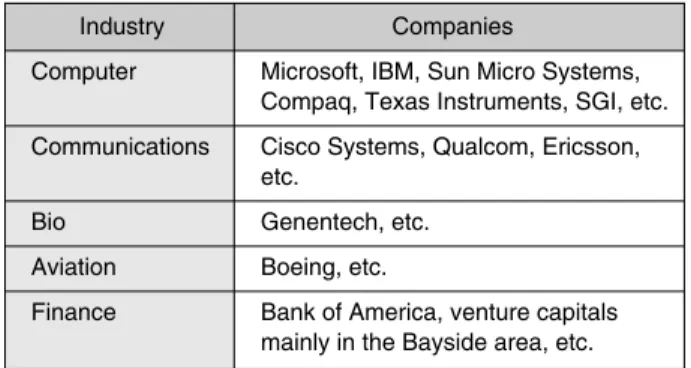6.1 Introduction
In California State, a large-scale technology innovation initiative (hereinafter referred as the
"CISI Initiative") is being executed jointly by members in the sectors of industr y, administration and academy.
The purpose of this Initiative is to construct the foundation for technological innovations looking ahead to the next 20 to 30 years, in order to maintain California State's position as a high tech area with the wor ld most advanced technologies in the 21st century.This program is scheduled to last 4 years from 2001 to 2004, and its budget is expected to reach $1.2 billion or more in total.
California State has succeeded in technological innovations including IT and biotechnology, etc., for the past 30 years and has successively given various new technologies to the world. It is worth noticing that Califor nia State, with these potentialities, has started a large-scale technology innovation initiative.
In this report, we introduce the outlines of this Initiative, mainly focusing on the outlines and
research costs of CISI (California Institute for Science and Innovation), the core of the CISI Initiative.
6.2 The origin of the CISI Initiative
The first person who proposed establishing the CISI Initiative is Mr. Davis, Governor of California State.
Recently, the number of companies that have transferred from California State to other states is increasing. This is backed by the sudden rise in wages and rents in California over the past several years, due to the booms mainly in the Internet businesses, and the electric crisis in California since last year.
Under these circumstances, Governor Davis felt anxious about the deterioration of the research and development capability of California, and decided to promote the CISI Initiative.
6.3 Core institutes of the CISI Initiative
"California Institute for Science and Innovation
40
S C I E N C E & T E C H N O L O G Y T R E N D S
6
Trends in the California State Technology Innovation Initiative
TOMOE KIYOSADA
Information and Communications Research Unit
Table 1:Member institutes of CISI
Institute School of UC in charge
QB3 — San Francisco School (Leader)
California Institute for Science and — Berkeley School Innovation in Bioengineering, — Santa Cruz School Biotechnology and Quantitative
Biomedicine
CAL (IT)2 — San Diego School (Leader)
California Institute of Communications — Irvine School and Information Technology
CNSI — Los Angeles School (Leader)
California Nanosystems Institute — Santa Barbara School
CITRIS — Berkeley School (Leader)
Center for Information Technology — Davis School Research in the Interest of Society — Santa Cruz School
— Merced School
(CISI)" established in University of California (UC) takes the leading role in the CISI Initiative.
CISI is composed of 4 institutes as shown in Table 1. These institutes had jointly been established with the respective schools of UC. In the research and development activities of CISI, other schools of UC, national laboratories in California State and private companies, etc., participate.
6.4 Interdisciplinary researches of CISI
The core research of QB3is in bio, CAL (IT)2in IT, CNSI in nanotechnology, and CITRIS in IT within society, respectively. CISI proceeds with interdisciplinar y researches by fusing these research areas.
(1) QB3
The objective of QB3 is to analyze somatological functions on various levels ranging from an atom, protein to a cell, the skin, an organ and the entire somatological system, and to resolve the complicated somatological mechanisms.
For this purpose, this group proceeds with researches by fusing mathematics, physic, chemistry, and engineering, etc., together on the basis of biomedicine.
(2) CAL (IT)2
With the broadband network age of large-capacity, high-speed communications just ahead, CAL (IT)2 repeats the discussion concerning "30 years hence, what kinds of Internet environments will be available and what kinds of services will be required?," etc., among experts of various fields including electr ic/electronics engineer ing, software engineer ing, communications engineering, cognitive science and sociology, etc., to proceed in researches on device technologies and applications, which seem likely to be required in future. The major themes currently being executed are as shown in Table 2.
(3) CNSI
CNSI proceeds with var ious research and development activities on the nanoscale with experts from various fields including material science, optoelectronics, biomimetics, and molecular biology, etc.
Concrete research themes of CNSI are as shown in Table 3.
(4) CITRIS
CITRIS forecasts, "IT will be newly developed in the fields of applications to societies instead of in
41
Q U A R T E R L Y R E V I E W N o . 2 / O c t o b e r 2 0 0 2
Table 2:Major themes of CAL (IT)2
Theme Description
Smart Roads To construct a system that solves traffic jams by measuring traffic with sensors installed on roads. To construct a traffic system materializing “No traffic accident /No traffic jam”
by having vehicles communicate with each other.
Large-scale analysis To develop software for executing large-scale calculations such as gene analysis, etc., using PCs at ordinary by connecting several million PCs at ordinary homes.
homes
Environment/Civil To develop various high-performance sensors with mobile functions in order to improve engineering monitoring accuracies of pollution forecasts and earthquake observations.
Table 3:Major themes of CNSI
Theme Description
Nano construction Construction analysis and designs on an atomic level, etc.
Nano image Research and development of image processing and image analyzing technologies on an atomic level, etc.
Simulation Numerical analysis related to physical properties of materials and crystalline growths on an atomic level, etc.
Molecular medical Researches related to mutations of pathogenic genes by using nano systems, etc.
treatment
Nano device Development of architectures and devices with molecular electronics, etc.
its own field in the future", and proceeds with researches on SISs (Societal-scale Information Systems).
SISs are systems integrating various devices including small-sized sensors, actuators, mobile information terminals, workstations, and a group of supercomputers occupying an entire room, etc., in accordance with social needs. Researches are being executed according to the individual themes shown in Table 4.
6.5 Research costs of the CISI Initiative
The California State Government will invest $100 million (about ¥12.5 billion) for 4 years to QB3, CAL (IT)2, CNSI, and CITRIS.
Since the state government imposes duties on the respective institutes to procure research costs more than double of the state government's donation from external organizations (private companies, federal government, etc.),the budget for the Initiative are expected to be more than
$1.2 billion (about ¥150 billion) for 4 years.
6.6 Influences of
the CISI Initiative on research activities in UC
Since research costs are regularly disbursed to UC from the state gover nment, as a univer sity established by the state government, there is the
question, "Whether the disbursement to the CISI Initiative from the state government will be treated as a kind of new expenditure separate from the ordinary disbursement, or it is the same expenditure as usual with just another item added?" In this section, we analyze the influences of the CISI Initiative on the research activities in UC.
The state gover nment will disbur se a fixed amount to the respective institutes of the Initiative. In other words, the state government will disburse $25 million (about ¥3.1 billion) annually for 4 years from 2001 to 2004 to the respective institutes of QB3, CAL (IT)2, and CNSI, which have been established from the beginning, and $33 million (about ¥41 billion) annually for 3 years from fiscal 2002 to 2004 to CITRIS, which was established later.
The total amount that had been disbursed from
42
S C I E N C E & T E C H N O L O G Y T R E N D S
Fiscal Fiscal Fiscal Fiscal
2001 2002 2003 2004 Total
QB3
25 25 25 25 100
CAL
(IT)2 25 25 25 25 100
CNSI 25 25 25 25 100
CITRIS
33 33 33 100
Table 4:Major themes of SISs
Theme Description
Improvement of energy To control the use of energies by connecting together inexpensive, small-sized sensors
efficiency through networks.
Traffics To calculate optimum routes by installing sensors on roads in California State, and connecting them through networks to analyze traffic at each site.
Prevention of disasters To construct information systems in which conditions of buildings, bridges and lifeline (Measures against networks, etc., are monitored on a real time basis, and systems informing of the safety earthquakes) of individual citizens to provide assistance each minute.
Education To provide distance learning programs to schools and companies in California State.
For the time being, lessons on info-communications for students of UC Merced will be provided.
Healthcare To develop sensors to detect abnormal physical conditions of patients and to inform doctors of it. To develop devices for monitoring health conditions of residents or solders in remote areas.
Environment To develop a system for measuring environmental conditions in a area from Monterey Bay of California State to the urban area of South California as the first step.
Then, to develop smart farming to improve the quality of crops in accordance with the environments.
Table 5:Research costs to be disbursed from the state government to CISI
(Unit: $ million)
the state government to CISI in fiscal 2001 was
$75 million, and another $33 million will be added to this in fiscal 2002.
On the other hand, the secular change of the research costs of UC is as shown in Table 6.We can observer that the cost for fiscal 2001 increased by
$88 million from the previous year, and the cost for fiscal 2002 will increase by $17 million.
From the above-mentioned points, we can observe a correlation between the disbursement from the state government to CISI, and the increase of research cost of UC.
We can see that the Initiative is a newly started activity, instead of an activity in which the name has been changed from an ordinar y research project in UC. Furthermore, we can observe that the budget for the CISI Initiative accounts for slightly less than 20% of the research cost of UC.
6.7 Cooperation among members from the sectors of industry, administration and academy in the CISI Initiative
Under the strong leadership of Governor Davis, the CISI Initiative is promoted with the participation of the respective schools of UC, national laborator ies (Los Alamos National Laborator y, Laurence Liver more National Laborator y and Laurence Berkele y National Laboratory) and more than 200 private companies within and outside of California State (as shown in Table 7).
The Initiative expects the following cooperation
from the private companies.
— Donations
— Shortening the lead time for materializing commercial products as fruits of the research activities
(Providing ideas and measures, etc., for producing commercial products)
— Human resource development (Teaching business concepts to students)
— Accepting students for internships
6.8 Conclusion
The CISI Initiative is a trial of California State in order for the state to continue as the world's most advanced, high-tech region in the 21stcentury.
In the Initiative, new technological seeds are pursued, and the industry and academy cooperate closely to proceed with researches by taking into consideration industrial needs.
In consideration of the fact that the state government and UC are fully cooperating in this large-scale Initiative, it is highly expected that new cutting edge technolog y for the coming generation will be born in the future. Thus, it is worthy to watch with interest the trends of this Initiative in the future.
43
Q U A R T E R L Y R E V I E W N o . 2 / O c t o b e r 2 0 0 2
Table 6:Research costs of UC
(Unit: $ million) Fiscal year Research cost The amount increased
from the previous year
2002 (estimate) 551 17
2001 534 88
2000 446 —
Table 7:Participating companies of the interdisciplinary initiative
Industry Companies
Computer Microsoft, IBM, Sun Micro Systems, Compaq, Texas Instruments, SGI, etc.
Communications Cisco Systems, Qualcom, Ericsson, etc.
Bio Genentech, etc.
Aviation Boeing, etc.
Finance Bank of America, venture capitals mainly in the Bayside area, etc.
Source: CISI official web site
http://www.ucop.edu/california-institutes/
(Original Japanese version: published in August 2001)



